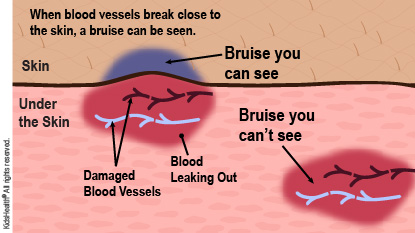Forehead Contusion: How to Care for Your Child
A forehead contusion (bruise) happens when a blow to the forehead injures the skin and soft tissue under it. Small blood vessels can leak blood, causing red or purple marks on the skin. Some contusions are deeper and involve the muscle. Health care providers can't see deep bruises, but they may feel a lump or swelling in the injured area. As contusions heal, they turn different colors before fading away. Most go away after 2 weeks.


-
An adult who can watch for new symptoms should be with your child for the first 24 hours.
-
To reduce forehead swelling, for the first 2–3 days:
-
While your child is awake, apply ice wrapped in a cloth for 15–20 minutes 3–4 times a day. Do not put ice directly on the skin.
-
If your child is old enough to use pillows, use an extra pillow to help raise the head during sleep.
-
You can give medicine for pain if your health care provider says it's OK. Use these medicines exactly as directed:
-
acetaminophen (such as Tylenol® or a store brand)
-
OR
-
ibuprofen (such as Advil®, Motrin®, or a store brand). Do not give to babies under 6 months old.
-
Do not give any other medicines for pain unless the health care provider tells you to.
-
Let your child sleep. There's no need to keep a child awake after a forehead contusion. Depending on how and when the contusion happened, your child's age, and other details, the health care provider may ask you to check on your child during sleep. Follow these instructions carefully.
-
Have your child avoid sports or rough play for at least 24 hours and until he or she is feeling better.

Your child:
-
still has the swelling or a bruise after 2 weeks
-
continues to have headaches longer than a day or two
-
has drainage, warmth, or more redness around the bruise
-
develops a fever

Your child:
-
has a severe headache or a headache that gets worse
-
is vomiting
-
is not speaking normally
-
seems confused or becomes clumsy
-
is very sleepy, can't wake up, or has a seizure

How do health care providers diagnose a forehead contusion? Health care providers carefully examine the injured area and ask about what happened. If the health care provider has concerns about a different type of injury, your child may need to have X-rays.
Can forehead contusions be prevented? Yes, avoiding injuries can prevent some forehead contusions. Follow these tips:
-
Make sure your child wears the right safety gear such as a helmet, eye guard, mouth guard, or face mask when playing contact sports.
-
Teach your child how to protect the face if involved in a fight.
-
Keep floors free of clutter.
-
Keep cords away from open areas.
-
Keep furniture out of walking paths in the house.
-
Don't use infant walkers.